Hanukkah – The Jewish Saturnalia

Idolatry has always been a snare to Yahweh’s chosen people. Abram, the first of the Hebrews, was called out of Ur of the Chaldees by Yahweh. Ur lay in the land of Babylonia, the most ancient source of idolatry. Undoubtedly, when Yahweh appeared to Abram calling him to “Go forth from your country, and from your relatives and from your father’s house, to the land which I will show you” (Genesis 12:1), the instruction was to leave the idolatrous practices of his family, and of the land of the Chaldeans behind. It is not speculation to suggest that Abram came from a family of idolaters. The Scriptures inform us of the fact.
Joshua 24:2-3
And Joshua said to all the people, “Thus says Yahweh, the God of Israel, ‘From ancient times your fathers lived beyond the River, namely, Terah, the father of Abraham and the father of Nahor, and they served other gods. Then I took your father Abraham from beyond the River, and led him through all the land of Canaan, and multiplied his descendants…’”
The Chaldean name Ur translates as “flame,” or “light.” The Chaldeans were renowned for their astrology, a mixture of astronomy and deity worship. Ur’s designation as “the Light of the Chaldeans” was almost certainly a reference to the heavenly lights that were the focus of their worship. Indeed, the prominence of astral worship was so great among the inhabitants of Chaldea that the name Chaldean has become synonymous with “astrologer.” Abraham’s descendants demonstrated a penchant for returning to the worship of the celestial lights. This proclivity toward worship of the Sun, moon, and starry hosts (including the planets) was so strong that Yahweh was induced to warn the Hebrews against the practice.
Deuteronomy 4:19
And beware, lest you lift up your eyes to heaven and see the sun and the moon and the stars, all the host of heaven, and be drawn away and worship them and serve them…
These words were spoken four centuries after the death of Abraham, at a time when Moses was leading the Israelites out from captivity in Egypt. When the Israelites came up from Egypt, they were not the pure and devoted worshipers of Yahweh that some imagine them to be. The prophet Amos provides the following testimony.
Amos 5:25-27
Did you bring to Me sacrifices and cereal offerings during those forty years in the wilderness, O house of Israel? No but instead of bringing Me the appointed sacrifices you carried about the tent of your king Sakkuth and Kaiwan [names for the gods of the planet Saturn], your images of your star-god which you made for yourselves and you will do so again. Therefore I will cause you to go into exile beyond Damascus, says the Lord, whose name is the God of hosts.
[Amplified Bible]
It is pertinent to our present study to note that at least one of the gods named by Amos is identified with the Roman deity known as Saturn. This was the understanding of the Jewish translators of the Septuagint, an early translation of the Hebrew Scriptures into Greek dated around the 3rd century B.C.. In the Septuagint, the Hebrew word Chiun (Kaiwan) was rendered as “Remphan” which was the Egyptian name for the planet Saturn. Evidence points to the Jews having embraced the worship of Saturn while in Babylon. It is this idolatrous worship that serves as the true origin of the Festival of Lights, which is also called Hanukkah.
I was astonished recently when I came across a serious Bible teacher proclaiming that the Jews finally learned the lesson that Yahweh wanted to teach them while they were in captivity in Babylon. The writer asserted that the Jews put away their idolatrous tendencies from the time of the Babylonian captivity forward and became zealous adherents to, and proponents of, Yahweh and the sacred Scriptures which He had entrusted to them. How can a Christian minister defend such a claim? The people of whom he speaks murdered the Son of God when He visited them.
Was there ever a time when the Hebrew people became associated with another nation whether through intermarrying, through conquest, or through alliances, when they did not transgress by adopting their idolatrous practices? Why would it be assumed that the Jews period of habitation in Babylon, a land that was “mad over their idols” (Jeremiah 50:38), would have a different result than any other period of Jewish history? Do we not read that when Jacob went to Haran to marry Rachel and Leah, upon his return the members of his household brought back idols with them (Genesis 31:34, 35:2)? Not many years later Jacob’s sons went down to Egypt. When they came up four centuries later, they brought the idols of the land with them.
During the period between the Egyptian captivity and that of the kings of Israel and Judah, a period recorded in the book of Judges, Abraham’s descendants were continually falling into idolatry. The idolatry continued during the time of the kings. Solomon married many foreign women and they turned his heart toward their gods. He built high places for them all around Jerusalem, leading the people of God into idolatry.
I Kings 11:7-8
Then Solomon built a high place for Chemosh the detestable idol of Moab, on the mountain which is east of Jerusalem, and for Molech the detestable idol of the sons of Ammon. Thus also he did for all his foreign wives, who burned incense and sacrificed to their gods.
This idolatry continued unabated in the northern kingdom of Israel, and knew only brief reprieves in the southern kingdom of Judah. Therefore, Yahweh judged the people and sold them into captivity to Assyria and Babylon.
Acts 7:39-44
“And our fathers were unwilling to be obedient to him, but repudiated him and in their hearts turned back to Egypt, saying to Aaron, ‘Make for us gods who will go before us; for this Moses who led us out of the land of Egypt – we do not know what happened to him.’ And at that time they made a calf and brought a sacrifice to the idol, and were rejoicing in the works of their hands. But God turned away and delivered them up to serve the host of heaven; as it is written in the book of the prophets, ‘It was not to Me that you offered victims and sacrifices forty years in the wilderness, was it, O house of Israel? You also took along the tabernacle of Moloch and the star of the god Rompha (Saturn), the images which you made to worship them. I also will remove you beyond Babylon.’”
Stephen, the first Christian martyr, testified of the Jewish people’s ceaseless spiritual adultery as they adopted the gods of other nations. As he was concluding the last words he would utter, Stephen declared, “You men who are stiff-necked and uncircumcised in heart and ears are always resisting the Holy Spirit; you are doing just as your fathers did” (Acts 7:51). Nothing had changed between the time of the Jewish captivity in Babylon circa 600 B.C. and the time of Christ. The Hebrew people remained wayward in their hearts. Pretending to be zealous for Yahweh and His word, they were in fact children of the devil as Yahshua testified.
John 8:42-44
Yahshua said to them, “If God were your Father, you would love Me; for I proceeded forth and have come from God, for I have not even come on My own initiative, but He sent Me. Why do you not understand what I am saying? It is because you cannot hear My word. You are of your father the devil, and you want to do the desires of your father.”
Rather than being the devoted students of God’s word that some perceive the Jews of Christ’s day to have been, they had gone so far astray in their hearts that they did Satan’s bidding by putting to death the Lord of glory. Is it too much to believe then, that these same men, and their descendants over the next centuries, would embrace a Babylonian festival to Saturn/Satan while covering it over with a thin veneer of Judaism in the same manner the Christians did with Christmas and the Roman Saturnalia? The Hanukiah is the “Flame of the Chaldeans” embraced once more by the descendants of Abraham. Satan had brought the Hebrew people full circle. The called out descendants of Abraham had returned to the idolatrous worship of their forefathers.
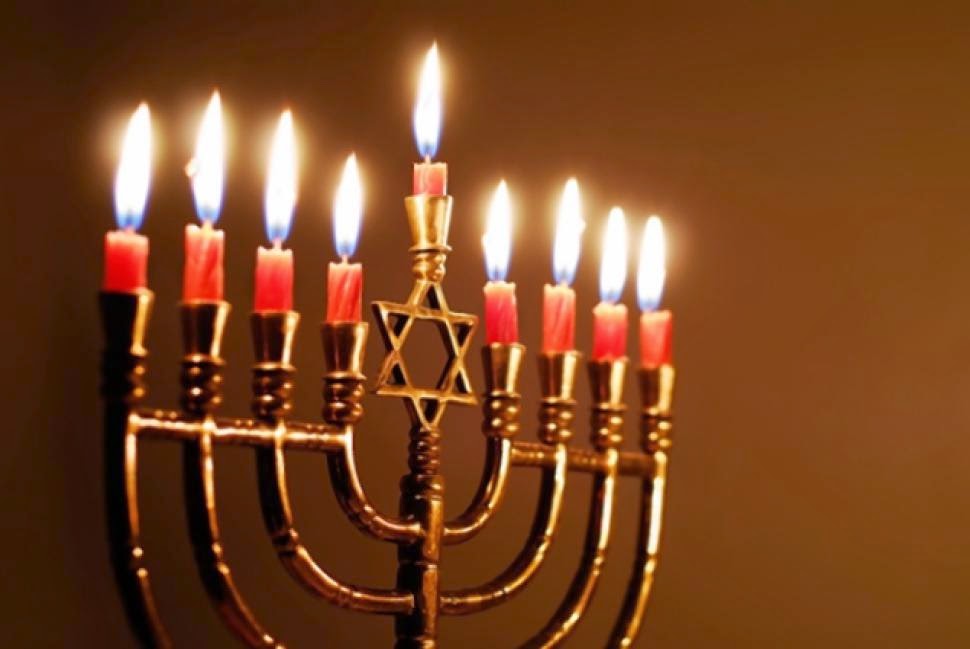
Flame/Light of the Chaldeans
The Chaldeans/Babylonians worshiped the heavenly host; the sun, moon, planets, and stars. I can imagine Satan engaging in deceit as he persuaded the Jews that they were in some manner honoring their forebears by returning to the more ancient faith of Abraham and his ancestors, returning to the worship of the heavenly host. This overt worship of the lights in the heavens and the deities they represented was commonplace in the Israelites pre-captivity history.
II Kings 17:16-19
And they forsook all the commandments of Yahweh their God and made for themselves molten images, even two calves, and made an Asherah and worshiped all the host of heaven and served Baal. Then they made their sons and their daughters pass through the fire, and practiced divination and enchantments, and sold themselves to do evil in the sight of Yahweh, provoking Him. So Yahweh was very angry with Israel, and removed them from His sight; none was left except the tribe of Judah. Also Judah did not keep the commandments of Yahweh their God, but walked in the customs which Israel had introduced.
After the captivity, the idolatry of the Hebrews obtained a more hidden nature. Instead of engaging in visible worship of Baal, Ashtoreth, Molech, Chemosh, Remphan/Saturn, and all the host of heaven, they began to introduce heretical elements of the worship of these gods into the worship of Yahweh. The rabbis through the Oral Torah, the Talmud, Midrash, and Kabbalistic writings, brought forth interpretations of the Bible/Tanakh that defiled the worship of Yahweh until it became the worship of Satan.
As an example of the sophistry employed by the rabbis, we find in the Talmud that the candlestick which stood in the Tabernacle of Moses and in the Temple of Solomon, has been re-interpreted to be symbolic of the seven visible planets. (From antiquity, the Sun, Moon, Mercury, Venus, Mars, Jupiter and Saturn have been recognized as seven celestial lights that differed from the stars in their motions. The five planets mentioned in this list are the only planets visible to the unaided eye.)
In the Midrash (Bamidbar Rabbah 15:7) the seven lamps of the Menorah are compared to the seven planets listed above. The Talmud goes much further in commenting on the symbolism of the lights of the Menorah and the planets associated with them. In Tractate Shabbat 156a we find the following commentary.
R. Hanina said to then, [his disciples]: Go out and tell the son of Levi, Not the constellation of the day but that of the hour is the determining influence. He who is born under the constellation of the sun will be a distinguished man: he will eat and drink of his own and his secrets will lie uncovered; if a thief, he will have no success. He who is born under Venus will be wealthy and unchaste [immoral]. What is the reason? Because fire was created therein. He who is born under Mercury will be of a retentive memory and wise. What is the reason? Because it [Mercury] is the sun’s scribe. He who is born under the Moon will be a man to suffer evil, building and demolishing, demolishing and building. eating and drinking that which is not his and his secrets will remain hidden: if a thief, he will be successful. He who is born under Saturn will be a man whose plans will be frustrated. Others say: All [nefarious] designs against him will be frustrated. He who is born under Zedek [Jupiter] will be a right-doing man [zadkan] R. Nahman b. Isaac observed: Right-doing in good deeds. He who is born under Mars will be a shedder of blood. R. Ashi observed: Either a surgeon, a thief, a slaughterer, or a circumciser. Rabbah said: I was born under Mars. Abaye retorted: You too inflict punishment and kill. It was stated. R. Hanina said: The planetary influence gives wisdom, the planetary influence gives wealth, and Israel stands under planetary influence.
This Talmudic entry sounds very much like Babylonian astrology, looking to the hour and day of one’s birth to forecast what a person’s life and character will be. It can hardly be coincidental that Mercury is mentioned as the Sun’s scribe, and the Romans held Mercury to be the messenger of the gods. There is clear evidence of idolatrous influences in the opinions of the rabbis which are recorded in the Talmud, and Midrash. This influence is even more pronounced in the Kabbalistic writings of the Jews. The primary document of Kabbalistic teaching, The Zohar, makes the following comment regarding the candlestick in the Jewish Temple: “These lamps, like the planets above, receive their light from the sun.”
Modern Freemasonry is derived from Kabbalah. We can therefore look to the writings of Freemasonry to discern what the Jewish mystics believed about the planets and their relationship to the golden candlestick, or menorah, that Moses commanded to be built. Frank C. Higgins in his book The Beginning of Masonry, published in 1916, writes the following regarding the Jewish seven-branched candlestick (the illustration is taken from his book):
Thus the seven planets were the seven old gods of the Babylonians, – Shamash, the Sun; Sin, the Moon; Nebo, Mercury; Ishtar, Venus; Nergal, Mars; Marduk, Jupiter; and Ea, Saturn.
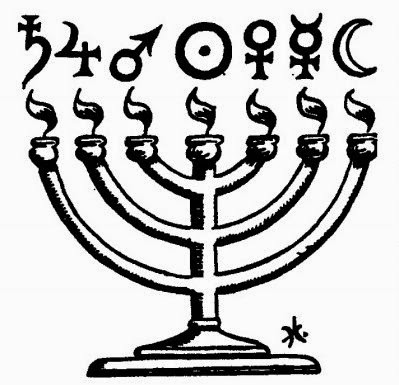
The Jewish seven-branched candlestick and its symbolism.
From left to right, the seven flames correspond to the following planets:
Saturn-Jupiter-Mars-the Sun-Venus-Mercury-the Moon
According to Talmudic dogma, it is forbidden for anyone to construct a seven-flame candlestick of the same pattern delivered to Moses. Consequently, any menorah that a Jew possesses in their home, in a synagogue, or any other public or private place, must have fewer than, or more than, seven lights. The Hanukiah abides by this stricture, as it possesses nine lights.
Did you note that Frank Higgins stated that the central flame, that which corresponds to the Sun, is called by the Babylonians “Shamash”? This is the same name the Jews give to the central candle on the Hanukiah, though they provide the explanation that the Hebrew word “Shamash” means “attendant,” or “servant.” The Talmud instructs the Jewish believer to always set the “Shamash” candle apart, either higher, or lower, than the other eight candles. Most typically, it is elevated over the other candles.

In the previous chapter it was mentioned that there is a specific order given in the Talmud, specifying how the candles on the Hanukiah are to be lit. This order is illustrated in the graphic above. The Shamash candle must be lit first. It is used to light every other candle. Supposedly, this is the reason for it being called Shamash, the attendant, or servant. This candle is the only one of the nine on the Hanukiah to be given a name.
One might ask, “How can the Hanukiah be related to the worship of Saturn if the central candle is named Shamash, and Shamash is the Babylonian name for the Sun and the deity it embodies?” On the Roman calendar, Sol Invictus Dies Natalis followed the Saturnalia. Sol Invictus was the celebration of the Birthday of the Unconquerable Sun (Which is the source of the Christian tradition of celebrating the birth of the Son of God on the same day). If the Shamash candle is representative of the Babylonian Sun-god, then we would have to logically conclude that Hanukkah is a solar festival, not a Saturnian festival.
Among the Babylonians, the Sun and Saturn had a very intriguing relationship. The name the Babylonians called Saturn by was Alap-Shamash, meaning “Star of the Sun.” It is interesting to note that a great many Hanukkah Menorahs incorporate what is referred to as ‘the star of David’ in the body of the candlestick. This six-pointed star is an ancient occult symbol relating to the worship of Satan.
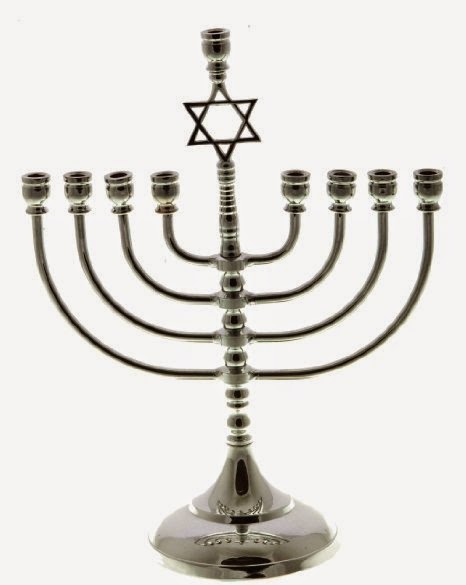
Satan is known by the name Lucifer which means “light bringer,” or “light bearer.” Satan styles himself as a benevolent being who has brought the light of wisdom and knowledge to mankind. Throughout human history he has donned many personas or images that are a variation on this theme. One of them is as Prometheus, the Titan who taught mankind the secret of fire and of many of the hidden arts of the gods. Because Prometheus defied the gods in giving forbidden knowledge to mankind, he was cruelly punished by Zeus, chained to a mountain side where a great eagle would daily come and eat his liver only to have it regenerate every night due to his immortality.

Prometheus Statue at Rockefeller Plaza, New York City
The Rockefeller family has erected a statue of Prometheus in New York City. The Rockefellers are an Illuminati family. They serve the one who claims to be a bringer of light to mankind. Satan rewards those who worship him. In the gospel of Matthew, we observe him offering to reward the Son of God if He would only bow down before him.
Matthew 4:8-11
Again, the devil took Him to a very high mountain, and showed Him all the kingdoms of the world, and their glory; and he said to Him, “All these things will I give You, if You fall down and worship me.” Then Yahshua said to him, “Begone, Satan! For it is written, ‘You shall worship the Lord your God, and serve Him only.’”
Although the Son of God rebuffed Satan and refused the “gifts” he offered, there have been many men and women who have sold their souls to the devil in order to receive fame, fortune, or some worldly gain in return. Among them are the Rockefellers and the Rothschilds. Tragically, many Jews have been led astray to worship Lucifer as the god of light. These are the same ones Yahshua declared to be sons of their father, the devil.
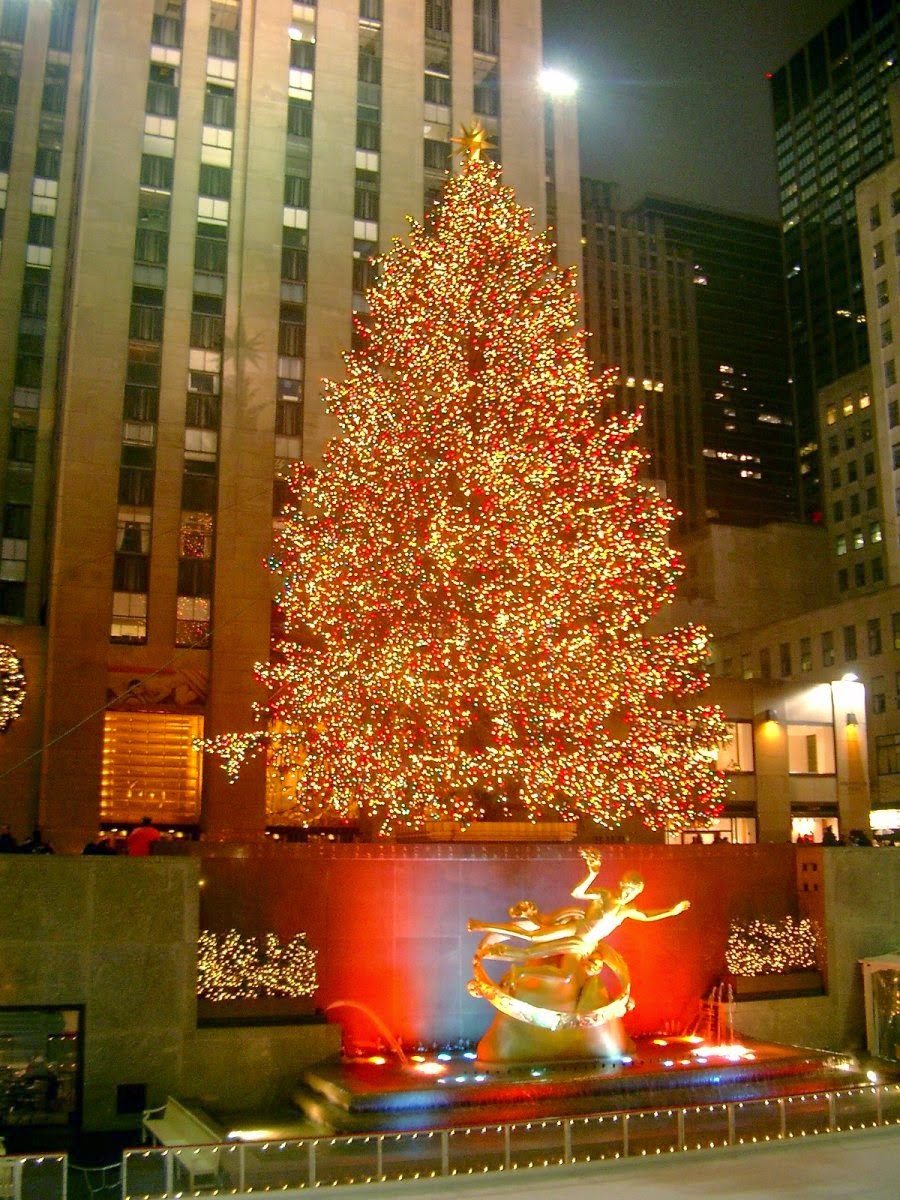
Prometheus at Rockefeller Center
Every Christmas, directly above the statue of Prometheus/Lucifer at Rockefeller Center, an enormous Christmas tree is erected amid much pomp. The tree is adorned with lights, and a blazing star signifying Lucifer, the angelic light bearer, crowns the top. Note the symbolism of Prometheus holding the gift of fire directly under the tree where the Christmas presents would be placed. Satan boasts of having brought the blazing light of knowledge to humanity. I would postulate that this is precisely the same image being presented with the Shamash candle which stands apart from and above the other candles on the Hanukiah. This candle is used to light all the others. Thus is Satan/Saturn/Lucifer depicted as being the source of all light, and bringing that light to mankind.
II Corinthians 11:13-15
For such men are false apostles, deceitful workers, disguising themselves as apostles of Christ. And no wonder, for even Satan disguises himself as an angel of light. Therefore it is not surprising if his servants also disguise themselves as servants of righteousness; whose end shall be according to their deeds.
When Satan tempted Adam and Eve to eat of the fruit of the tree of the knowledge of good and evil, he was offering them a gift. He was alluring them with forbidden knowledge. Yet, to Satan’s disciples, the transgression of this fallen angel is styled as a benevolent gift, and Yahweh is figured as a tyrant who punished Satan unjustly. In Satan’s guise as Prometheus, we read the following words regarding this being, the words being inscribed beneath the statue.
Prometheus, teacher in every art, brought the fire that hath proved to mortals a means to mighty ends.
In the New Testament the word for angel is also translated as “messenger.” Consequently, the phrase “angel of light” and “messenger of wisdom and knowledge” become synonymous with one another. What is depicted in the lighting of the Christmas tree and the laying of gifts beneath it, is the same story being told through the Shamash candle being used to light the eight candles of the Hanukiah. Lucifer, the light bringer, is portrayed as giving his light/wisdom/knowledge to mankind.
It is of little consequence whether Shamash refers to the Babylonian Sun-god, or whether it is a reference to Alap-Shamash, the deity associated with the planet Saturn. Both roads lead back to Satan who styles himself as the heavenly ruler and the source of light for all mankind. Recognizing that the days of the week are all dedicated to various deities, and understanding that Satan is an usurper, wanting to ascend to the place reserved for Yahweh, it follows logically that he would wish to usurp unto himself that day which is peculiarly reserved for the worship of Yahweh. In the Bible, that day is the Sabbath, the seventh day of the week. It is notable that the seventh day Sabbath has been replaced among a great many nations of the world with the worship of Saturn. Hence, in the English speaking portions of the world, we call the seventh day Saturday (Saturn’s Day).
Although it is not readily apparent why the planet Saturn would come to such prominence, since it is among the dimmest of the seven ancient planets due to its great distance from the Sun and earth, historians relate that this planet and the god it represents held a position of preeminence among the heavenly lights. Diodorus Siculus, a Greek historian who lived in the first century B.C., wrote that the Chaldeans regarded Saturn as the most prominent of the planets.
But above all in importance, they (the Chaldeans) say, in the study of the influence of the five stars known as planets, the one named Cronus by the Greeks (i.e., Saturn) is the most conspicuous.
Also affirming the elevated position of Saturn in the pantheon of the gods, we find that in the Sanskrit language Saturn is named Grahanayakah. This name is a compound of “graha(h)” (planet), and “nayakah” (chief or leader). Thus, Saturn was accorded the title of “Chief Planet” by those who spoke the ancient language of Sanskrit which flourished from approximately 2,000 B.C. until 600 B.C.. Sanskrist is the religious language of the Hindus, Buddhists, and Jains.
In Sanskrit another name attributed to Saturn is Shani. In this language the seventh day of the week is called Shanivar which translates as Saturn’s day. In Cambodia the seventh day is named in honor of Prah Sau, which again corresponds to the planet Saturn. In Japanese, the seventh day is Do Youbi, and is associated with Dosei (Saturn). In the solar calendar of Thailand, the name of the day is derived from a Pali word for Saturn (Pali now being an extinct language).
Throughout the world we find that the seventh day which was declared holy by Yahweh, has been supplanted by idolatrous religions that worshiped Saturn. If we follow the trail leading back to the worship of Saturn, we find additional correspondence with the celebration of Hanukkah. One of the chief sources on the Roman celebration of Saturnalia is the book titled Saturnalia written by Macrobius Ambrosius Theodosius. The date of this encyclopedic writing is around 400 A.D.. In this work it is stated that Saturn was considered by the Romans to be “the foremost of the gods” and that the Romans “celebrate Saturn with the greatest honor, among all the other (gods).”
In Macrobius’ Saturnalia, a character is discoursing on the origin of the festival and its various rites and symbols. He explains how the worship of Saturn became associated with the kindling of lights. The story goes that Saturn was formerly worshiped with human sacrifice. The heads of men who had been slain were required to appease the god. This changed when Hercules persuaded the people to substitute the offering of men for that of burning lights. It is explained that the Latin word “phota” means both “man” and “lights.” Thus the custom of exchanging candles during the Saturnalia began. (Source: Macrobius’ Saturnalia, edited and translated by Robert A. Kaster, page 81).
If one accepts this explanation of the lighting of the candles being a substitute for human sacrifice, it is a serious matter for those who light the Hanukiah. As each light is set ablaze it is offered up as a substitute for human sacrifice. In other words, the lives of mankind are being symbolically offered up to Saturn/Satan.
A second significance of the lighting of candles relates to the association between light and knowledge. Macrobius writes:
Others think that candles are exchanged precisely because it was under Saturn’s guidance that we passed out from a dark and uncultured way of life to the light cast by the knowledge of beneficial skills.
[Ibid, page 83]
Whether a person is symbolically offering human sacrifice to Satan, or honoring him as the giver of knowledge and gifts to mankind, the act is one of immense evil.
As I mentioned at the end of the preceding chapter, another association between Hanukkah and Saturnalia is derived from the alternate name The Feast of Dedication. The rabbis in the Talmud, and the authors of I and II Maccabees, inform us that it was the Jewish Temple in Jerusalem that is in reference here. Yet, if we peel away the deceit, and look back to a more ancient source for this celebration, we find that Saturnalia was held on the day that the Temple of Saturn was dedicated in Rome in the year 497 B.C., long before the reported victory of Judas Maccabeus over the Seleucid armies. Two further associations to Hanukkah are observed as we read what is revealed in the Wikipedia article on the feast of Saturnalia.
Saturnalia is a festival of light leading to the winter solstice, with the abundant presence of candles symbolizing the quest for knowledge and truth…
Gambling and dice-playing, normally prohibited, or at least frowned upon, were permitted for all, even slaves.
[Source: http://en.wikipedia.org/wiki/Saturnalia]
The Roman Saturnalia was referred to as the “Festival of Light.” This same name is given to the Jewish celebration of Hanukkah. From the second statement above we derive another correspondence. Other than the nine-candle menorah, one of the most widely associated symbols of Hanukkah today is the Dreidel.
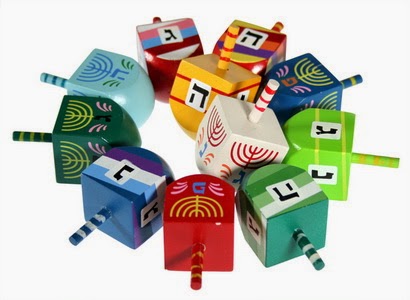
Dreidels
Dreidels are given as gifts, especially to children, during the eight days of Hanukkah. The dreidel originates from a gambling device called the teetotum. It is basically a dice that spins. The Wikipedia entry on the teetotum contains the following information.
In its earliest form the body was square (in some cases via a stick through a regular six-sided die), marked on the four sides by the letters A (Lat. aufer, take) indicating that the player takes one from the pool, D (Lat. depone, put down) when a fine has to be paid, N (Lat. nihil, nothing), and T (Lat. totum, all), when the whole pool is to be taken.
[Source: http://en.wikipedia.org/wiki/Teetotum]
A square with a stick in one side is a very good description of a dreidel. Is it mere coincidence that Saturnalia was “marked by gambling and dice-playing,” and the dreidel has become an inseparable part of the Hanukkah observance today?
A final association between Hanukkah and Saturnalia that I will mention to close this chapter, is the tradition of cooking oily foods, such as latkes (potato pancakes) during Hanukkah.

Latkes
The statue of Saturn in its temple in Rome has been described by ancient historians as being hollow and constructed of wood. Saturn is depicted as a veiled figure holding a scythe. The hollow statue was filled with oil. It is reported that it was filled anew every year on the anniversary of the dedication of Saturn’s temple. This is at the time of the Saturnalia festival, and corresponds to the season of Hanukkah.
One modern explanation for the emphasis on oily foods during Hanukkah points back to the miracle of the oil recorded in the Talmud. As has been shown, however, this story of the temple menorah burning for eight days on a single day’s worth of oil is a fabrication of the rabbis. It was not reported in the much older accounts in I and II Maccabees and in Josephus’ Antiquities of the Jews. A more plausible explanation for the emphasis on oil during Hanukkah is that the Jews practiced syncretism as they adopted the rites and symbols of the worship of Saturn. Saturn from antiquity has had an association with oil as is observed in the worship of Shani, which was mentioned earlier as a Hindu equivalent of Saturn. Shani was “one of the… nine primary celestial beings in Hindu astrology… Shani is embodied in the planet Saturn and is the Lord of Saturday” [Source: http://en.wikipedia.org/wiki/Shani]
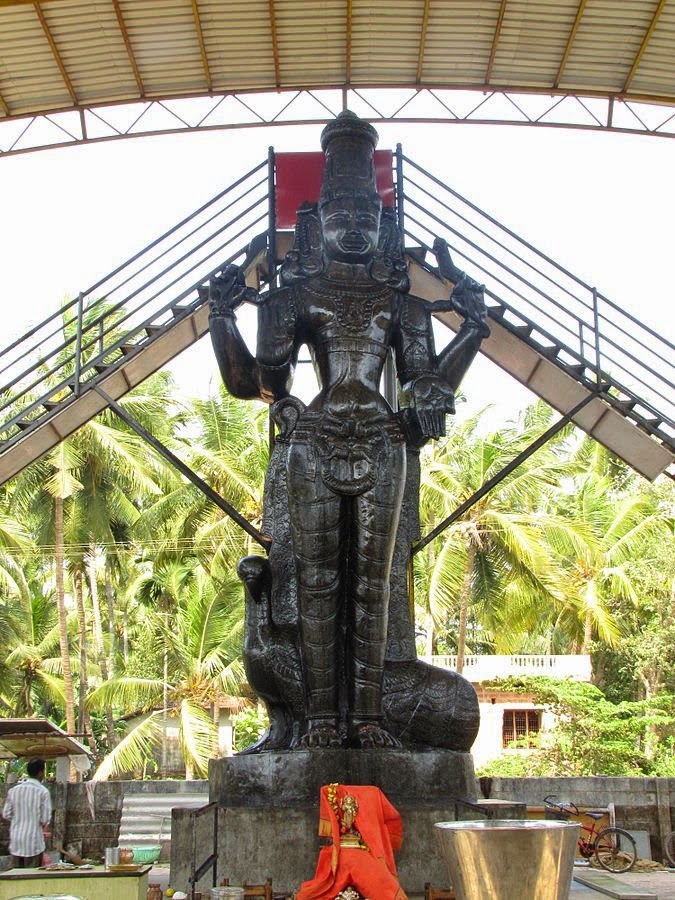
Note the ladder behind the statue to enable worshipers to ascend to the head of the idol in order to pour oil over it. This idol is found in India, a land of many languages. The rite of pouring oil over the statue is referred to in the following manner in the local languages. In Sanskrit, Telugu and Malayalam the rite is called Tailabhishekam (Tailam means oil). In Telugu the rite is also called Nuvvula Nune (Nuvvulu means Sesame; Nune means oil). In the language Kannada, the rite is referred to as Ellenne (Ellu means sesame; enne means oil).
There is an English expression that states, “If it looks like a duck, swims like a duck, and quacks like a duck, then it probably is a duck.” The Hanukkah celebration passes the test for being a Jewish adoption of the ancient worship of Saturn. It shares the same holiday names as Saturnalia: The Feast of Dedication; The Festival of lights. It shares the same rites with the lighting of the candles, the giving of dreidels as gifts, and the focus on oil. It even incorporates the Babylonian name Shamash, a name related to the worship of Saturn, in its major symbol and rite. Additional correspondence could be expounded upon, such as the traditional use of beeswax candles among the Hebrew celebration and in the ancient worship of Saturn.
If Christians are going to separate themselves from the observances of Christmas and Easter due to their proven links back to Roman and Babylonian idolatry, should they not do the same with the Jewish Hanukkah? Some further thoughts on this Hebrew festival will be shared in the following chapter as we segue into an exploration of related topics.
Heart4God Website: http://www.heart4god.ws
Parables Blog: www.parablesblog.blogspot.com
Mailing Address:
Joseph Herrin
P.O. Box 804
Montezuma, GA 31063


Saturn is the Son of Lord Surya ( The Sun God in Hindu Methology)… Ie. The meaning of Star of the Sun.
The purpose of Shani, is to humble human beings. To ensure they helps others less fortunate. He turns kings to paupers, and paupers to kings.It is a constant reminder for Hindus to do Seva whenever they can, so that they may not get very much effect. Shani also rewards one after such character growing.
His Ruler is Lord Hanuman… The monkey God.
If one prays to Lord Hanuman, Lord Shani does not interfere much.
Thanks for the gnosis…. Now I just need immortality.. Just joking.
Saturn is the Sun of Surya.
He is your Satan, but in Hinduism,Shani is there to punish one that had done wrong. After, the punishment time is over, he rewards you. Thanks, I learned much from you writings. Lakhan7[at]gmail.com
Well traced through history and carefully documented. May God bless you!